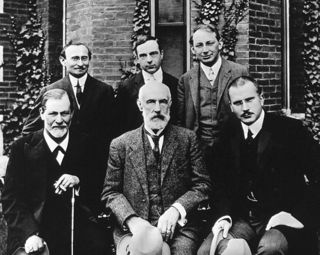Psychoanalysis
Freedom, Choice, and Psychoanalysis
In psychoanalytic treatment, the patient remains free to choose.
Posted September 19, 2019
Broadly defined, psychotherapy is the process of helping individuals deal with a variety of mental illnesses and emotional difficulties through human conversation. There exist hundreds of different schools of thought in psychotherapy, from the newer cognitive, behavioral, and mindfulness-based therapies to the time-honored psychoanalytic psychotherapy.

Some practitioners, like myself, practice from a particular theoretical persuasion, while others—perhaps most—define themselves as eclecticists, drawing on the range of theoretical orientations depending on the patient's presenting problem. (There are, however, important limitations to this eclectic approach, e.g., "The jack of all trades is a master of none.")
Understanding the philosophical underpinnings of psychotherapy is a vital, yet understudied and underappreciated element of evaluating the psychotherapy process. The differences between, say, cognitive behavioral therapy (CBT) and psychodynamic therapy exist not only in the minute-by-minute transactions in the therapy hour but also hidden beneath sight in the philosophical bases of these approaches.
When it comes to psychoanalysis (and psychoanalytic psychotherapy) — the oldest school of psychotherapeutic thought — various elements differentiate it from the other, more recent approaches to therapy. Among these is the psychoanalyst's focus on lifespan development, the transference and countertransference reactions, underlying psychological dynamics, and resistance and defense mechanisms.
However, I contend that the most significant factor distinguishing psychoanalytic treatment from other therapies is its preservation of the autonomy of the patient. In short, psychoanalysis values freedom.
While some scholars have investigated psychoanalysis on the basis of its relationship to freedom (see Szasz's 1965 Ethics of Psychoanalysis), the concept of freedom is usually rendered to discussions in political philosophy rather than psychotherapy. In fact, many psychoanalytic authors seem to overlook the historical importance placed by Freud and his followers on the freedom and self-determination of the patient.
Writing in 1914, Freud noted that the analyst must "leave untouched ... the patient's personal freedom" and should not "hinder the patient from carrying out unimportant intentions, even if they are foolish." Freud explicitly repudiated attempts to exert direct influence over the patient's life and behavior, leaving the patient free to conduct himself in any way he chooses outside of the therapy hour. In fact, it is perhaps this point which most clearly differentiated Freud from the psychiatry of his day.
It is clear, then, that from the earliest days of psychoanalysis, the discipline has rested on the belief in thoroughgoing self-determination. If the goal of psychoanalytic treatment is to free the patient from the constraints imposed on him by his symptoms — in essence, to support and expand the patient's personal freedom — then the therapist should not be in the business of dictating what the patient should, or should not, do. The role of the analyst, or analytic therapist, is to analyze, to understand, and to make sense of; it is not to direct the patient in the conduct of his own life.
(An important distinction should be made in dealing with the patient who poses a genuine and imminent risk of danger to self or others, though a discussion of these matters is beyond the scope of this article.)
How does this compare to CBT, the most common form of therapy offered today? In CBT, the therapist characteristically plays an active role in pointing out the patient's irrational thoughts and patterns of behavior, and, furthermore, instructs the patient to make changes in this regard. Thus, cognitive behavioral therapy is a directive form of psychotherapy. The patient's autonomy is restricted in the name of the treatment. So, too, in dialectical behavioral therapy, rational emotive behavior therapy, and other related approaches.
While this may sound like a rather trivial distinction, the consequences for treatment are profound. Take, for example, a depressed patient. In CBT, the depressed individual is told that his negativistic thoughts are causing (or at least worsening) his depressed mood, and the therapist challenges — sometimes directly — the rationality of these thoughts. In contrast, the psychoanalyst empathically receives the patient's beliefs and feelings and engages with the patient in a mutual investigation of the origin and meaning of them.
Perhaps no clinical situation makes the philosophical distinction between CBT and psychoanalysis as clear as the patient with addictive (or obsessional) behavior. In treating such a patient, a CBT therapist may require, as a stipulation for treatment, that the patient cease engagement in such behavior during the course of psychotherapy. The psychoanalyst makes no such requirement. The only requirement is that the patient desires to engage in an introspective self-examination. If the patient continues to engage in such behavior during the course of the treatment, it is to be examined as a part of the therapy.
It has been argued that the psychoanalyst's focus on the freedom of the patient in the therapeutic arrangement is precisely wherein psychoanalytic treatment derives its value and effectiveness (Szasz, 1965). Recognizing the origins and meanings of one's behavior, the patient becomes more capable of self-directed and self-initiated choice, a preferable alternative to change imposed on a patient by a therapist.
Furthermore, when a psychoanalytic therapist sways from a position of therapeutic neutrality, it is often exhibited in his active direction of the patient, i.e., his limiting of the patient's autonomy, and is interpreted as a manifestation of the therapist's own countertransference. Because so few contemporary therapists have an appreciation for these countertransference mechanisms, these behaviors — and their motivations — frequently go unexamined.
The psychoanalytic therapist, then, must personally value the ethic of freedom and must be devoid of any psychological need to control his patients. The authoritarian makes a very poor psychoanalyst.
When viewed through a philosophical lens, it is clear that psychoanalytic and non-psychoanalytic therapies differ most significantly in their approaches to freedom. Whereas directive therapies seek to limit choice in the name of treatment, psychoanalysis sees the patient's freedom to choose as necessary for lasting and meaningful change.
References
Freud, S. (1914). Remembering, repeating, and working through (Further recommendations in technique of psychoanalysis II). In J. Strachey (Ed. And Trans.). The standard edition of the complete psychological works of Sigmund Freud, Volume XII (1911-1913): The case of Schreber, papers on technique and other works, 145-156.
Szasz, T. S. (1965). The ethics of psychoanalysis: The theory and method of autonomous psychotherapy. New York, NY: Basic Books.




